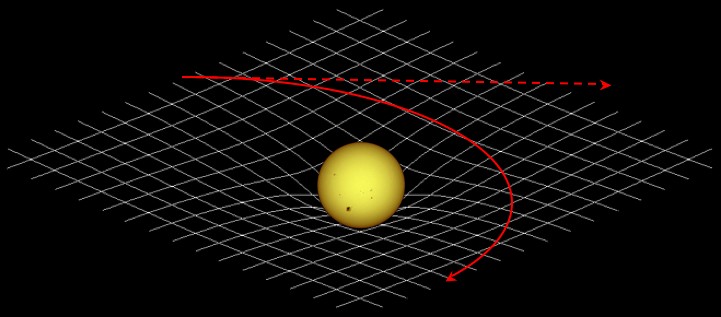
"There is a theory which states that if ever anyone discovers exactly what the Universe is for and why it is here, it will instantly disappear and be replaced by something even more bizarre and inexplicable.There is another theory which states that this has already happened."
--From "The Hitchhiker's Guide to the Galaxy" by Douglas Adams
A brief diversion on gravity. As we detailed in the last class, in the 1920's it was discovered that the galaxies were all moving away from each other. But a few years before this, a new theory to explain gravity called "General Relativity" was being developed by Albert Einstein. While Newton could explain how planets moved by invoking gravity, he could not describe what gravity was. Einstein solved this problem--this is best described in this brief video. General Relativity provides us with the real insight into how the Universe works: space and time are intimately connected, forming "space-time", and this fabric (both time and distance) can be altered by mass,

and by speed. Note that one of the tenets of Einstein's ideas is that the speed of light is always a constant. This is somewhat hard to understand. For example, if I am on a train moving 100 m/s and I shoot a gun whose bullets travel at 1000 m/s, then the speed of the bullet is 1100 m/s. But this is not true for light. If I am in a space ship traveling at half the speed of light (0.5 c) and I shoot a laser beam out the front, light does not travel at 1.5 c, it always travels at 1.0 c. The understanding of how this is possible results from Einstein's theory Special Relativity---which discusses how different observers measure both length and time intervals: "time dilation" (objects moving at very high speed through space have slower running clocks--that is for someone that is not moving, the clocks on the high speed space ship run at a slower rate), and "length contraction" (fast moving objects appear shorter than an identical, but non-moving object). This is a complicated subject, but here are some videos that attempt to allow you to understand these concepts a bit better (we will return to this subject when we talk about interstellar space travel!): #1, #2.
How can we explain the observation that all galaxies in the Universe are moving away from us, and the further they are away from us, the faster they seem to be moving? It appeared that the most obvious explanation was that the Universe began with a tremendous explosion, and that all of the material that would eventually form the galaxies and stars was hurled outwards at high velocity (animation). Note: the idea of an explosion at some single point cannot explain Hubble's law--if you think about a firecracker or bomb going off, most of the stuff ejected by such an explosion travel at similar speeds--that is, all of the objects would have roughly the same speed, and near-neighbors would not move apart very rapidly in a relative sense---objects just in front, and just behind an ejected blob more or less keep their same separations. But this is not what is observed for galaxies! But this meant that there was a beginning. This theory was dubbed the "Big Bang" by Fred Hoyle, who found the idea of a beginning for the Universe to be philosophically objectionable. If it had a beginning, where did it come from? What came before the Big Bang? What did it "bang" into? These questions were too metaphysical for Hoyle. So, along with some collaborators, Hoyle proposed the "Steady State" model in 1948. [In the Steady State model, matter is being spontaneously created (at a relatively small, and constant rate) throughout the Universe. The Universe then had to expand to keep the average density constant. Of course, why the Universe would choose to do this is unknown--it seems no more hokey than the Big Bang.] The Steady State theory was a fairly solid piece of work that could explain the recessional motion of the galaxies, and since the mass creation rate was rather small, it would not be very easy to detect, and therefore quite difficult to disprove. The contest between the two rival models was extremely useful: by criticizing each other, both models would get better by fixing their flaws. But soon, other evidence would overwhelming confirm the Big Bang picture.
Back in 1916 when Einstein published his Theory of General Relativity, he ran into the same paradox as had Newton: in a static Universe with an infinite age and with an attractive gravitational force, all objects would eventually end up in a single spot and merge. In Einstein's formulation of general relativity, a static Universe was not predicted. To make the Universe remain static, Einstein had to introduce a "cosmological constant" that would act to balance the force of gravity--an artificial "anti-gravity" force. After learning of the expansion of the Universe, Einstein called the cosmological constant "the greatest blunder of my career", as general relativity predicted that the Universe should either be expanding or contracting.
The Russian physicist Alexander Freidmann took General Relativity ("GR") at its face value, and ignored Einstein's cosmological constant. He believed that there was one, and only one model for the Universe that was predicted by GR: "In this model the Universe begins from zero volume and infinite density and expands from the beginning of time. During the expansion gravity would always be pulling at everything in the Universe, eventually it would win. After the Universe had expanded for a certain time it would begin to contract and fall back to it's original state of zero volume and infinite density. This is what is termed as a "closed Universe". In 1922 Freidmann published his work, which included a prediction that would be independently found by observation in 1929 by Edwin Hubble."1
Thus, Friedmann's solution of GR was predicting an expanding (or contracting) Universe, and Hubble's observations confirmed this prediction. The Friedmann solution was attractive in that it appeared that the Universe could recycle. That is, a Big Bang would occur, the galaxies/matter/space would expand out to some distance where they would stop, and then reverse their motions to end in a "big crunch", from which a new Universe/Big Bang could originate. This Friedmann model is called the closed model of the Universe:
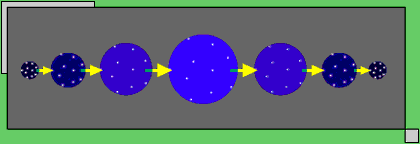
This is a philosophically appealing model---as you don't have to say what started the whole thing! The Big Bang is merely the start of a new cycle with is the result of a natural oscillation.
Work in the 30's by the American physicist Howard Robertson and the British mathematician Arthur Walker found that Friedmann had been incorrect, there were in fact three solutions to GR that explained the current expansion. The recycling one, and two others, the "flat model", where the Universe would continue to expand, but the expansion would keep slowing down due to the gravitation of all of the matter in the Universe until it reached zero velocity at some infinite time:


Our textbook shows it this way:
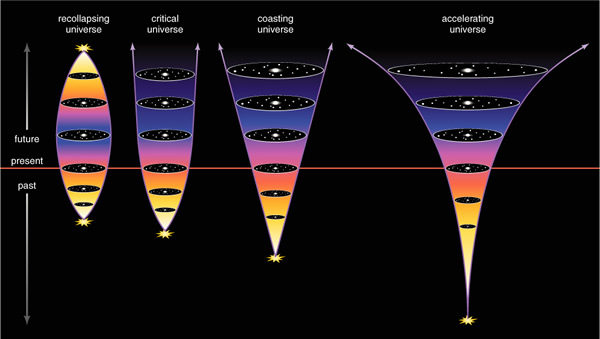
Another way to look at these models is in the graph of size vs. time:
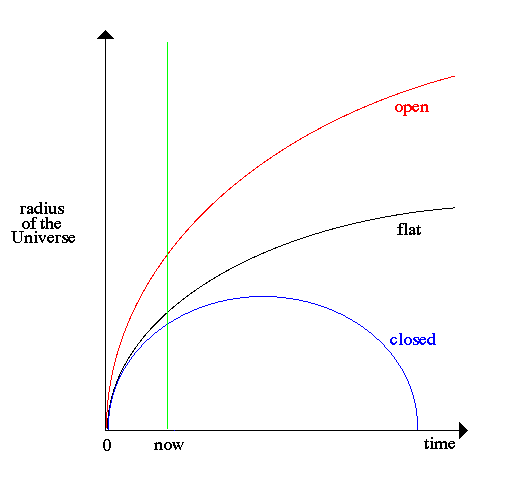
Thus, we now have a way of understanding the motion of the matter in the Universe. But these ideas were more than that, they give us a framework in which to interpret the observed expansion, and thus one could make testable predictions. So, let's begin by "running the movie backwards" and see if we can make sense of it. Remember, we can always do this for any event, just like this explosion movie, or these exploding timepieces (not to be confused with this).
This process leads to a number of predictions, but the most important one was that very early in the history of the Universe, shortly after the Big Bang began, everything in the Universe was extremely hot, and this heat should have produced an enormous amount light, and that this radiation should be detectable--the fossil record of this phase. The story goes:
"In the early 60's, Bell Labs built a giant antenna in Holmdel, New Jersey, in 1960 as part of a very early satellite transmission system. It quickly became obsolete for its original use. Arno Penzias and Robert Wilson refurbished it with improved radio receivers, but they kept coming up against an annoying noise (like static in radio or snow on a TV) that the receivers only seemed to have when they were on the antenna. Such problems were often found to be due to faults in the antenna itself, and Penzias and Wilson worked to make improvements there -- even to removing quantities of Pigeon poop they delicately described in terms more engineering than biological as "a white dielectric substance"... Nothing made the noise go away, so they went to visit an eminent radio astronomer, Robert Dicke at the nearby Princeton University -- Dicke was a world-renowned authority on radio receiver noise.
By strange coincidence, Dicke and a colleague, Jim Peebles, had become interested in searching for remnant radiation from the Big Bang and had even built a simple receiver and started searching for it. Dicke immediately suspected that Penzias and Wilson had blundered onto this source -- "We've been scooped." he reported. The two groups joined efforts and quickly confirmed that the remnant radiation had indeed been found -- the 'fossil record' that Hoyle had required to accept the Big Bang theory.
Although most astronomers quickly abandoned the Steady State model, Hoyle defended it doggedly, pointing out flaws and inconsistencies in the Big Bang theories and elaborating on the Steady State model to provide its own radiation field that might be mistaken for the remnant of the Big Bang. He continued to defend the theory until his death, in 1999. Although the later phases of this work were not well received, the earlier ones pointed out genuine weaknesses in Big Bang theory which others worked to fix. In this way, Hoyle continued to contribute to the improvement of the theory he opposed."3
The detection of this fossil radiation, technically called the Cosmic Microwave Background (CMB), was a major hurdle for the Big Bang model. The photons that were created soon after the Universe began were being emitted everywhere in the Universe. But because the Universe was/is expanding, it has taken the entire age of the Universe for these photons to get to Earth. In the process, they have been redshifted, just like the light from all of the galaxies we can see--but in this case the redshift is extreme: optical photons have been turned into microwaves! ( here is a graphic that shows the electromagnetic spectrum, from gamma-rays to radio). Because we know the expansion rate, and the approximate time when these photons were emitted, one could predict the spectrum of the Universe, and what it should look like now. Thus, theorists predicted that the spectrum would be a blackbody having a temperature of 2.73 degrees above absolute zero. In the early 90's a sensitive satellite was built to examine this radiation (COBE) and produced the following spectrum for the CMB:

Both the data and the predicted spectrum are plotted here! Truly one of the finest scientific proofs ever executed.
So, what is the final resolution of Olber's paradox? There are two main effects that explain why the sky is dark at night. The first is the fact that the Universe had a beginning, and therefore is not infinite in size. If it is not infinite, then given the relatively low density of objects that produce light, they cannot sum together to create a uniform surface of shining material. The other point to realize about the Big Bang model is the "horizon effect". The furthest away we can see an object, our "horizon", is the radius at which the Hubble expansion equals the speed of light. But objects at that distance have their light redshifted by an enormous factor (like the Cosmic Microwave Background). Thus, any light from distant objects is redshifted so much that it is effectively "dark", that is, not detectable to the human eye. The first effect is more important in our Universe, but if there was a lot more shiny stuff in our Universe, then it still could have been large enough to retain Olber's paradox. But an expanding Universe will always suffer from a horizon effect.
A Brief History of the Universe The Big Bang model has passed a great variety of tests, and has became the working model for the origin and nature of our Universe. Now comes the hard part, trying to understand what is actually happening! Using what we know about the physics of matter, we can run the clock backwards to earlier, and earlier epochs in the history of the Universe we can begin to draw a picture of the history of the Universe. Starting at the present, where the estimated age of the Universe is about 13.5 billion years old, the "temperature" of the Universe is 2.73 K and the mean density is only 10-27 kg/m3 (note that this density is almost exactly one hydrogen atom per cubic meter!). How long ago did the first stars and galaxies form? That question has not yet been fully answered, but the current view is that these objects began to form about 1 or 2 billion years after the Big Bang, so about 11 billion years ago. At this time the "radius" of the Universe was about 10X smaller than today (1/1000 the volume of today), and the mean density was roughly 10-24 kg/m3. The Universe was still quite cold, with a temperature of 18 K (18 degrees above absolute zero).
The next big event on our backwards trip in time is the moment the Universe became transparent ("optically thin"). This occurred about 1 million years after the Big Bang. This is an important time, for up to now, any radiation (light/heat) created in the Big Bang cannot escape, and the Universe cannot cool--this means that atoms, combinations of protons and electrons, cannot get together to form elements--thus nothing except free subatomic particles (including some nuclei, such as helium) existed at this time. Once the Universe became transparent, the protons and electrons could combine to form atoms. Once the atoms formed, they could start to collect together to form the primordial gas clouds that eventually lead to the creation of stars and galaxies. This is also the time when the CMB radiation "escapes".
We now jump to a moment only a few thousand years after the Big Bang: at this time the temperature of the Universe is 100 million degrees--like the center of a star. At these temperatures, protons and neutrons are forced together to make the nucleus of the hydrogen isotope dueterium (one neutron and one proton), as well as a small amounts of Helium nuclei (which are composed of two protons and two neutrons). This is the so-called Big Bang "nucleosynthesis" era, where nuclei are formed, or "synthesized", just like the centers of stars today--the entire Universe was like the core of star!
We can continue to run the clock back and predict both densities and temperatures at even earlier epochs. During the interval of 15 seconds after the Big Bang, and 3 minutes after the Big Bang, the Universe was so hot and dense that individual gamma-ray photons could interact to create electrons and positrons (anti-electrons), that would, in-turn, annihilate. The process is shown here (figure 23.3):
Somehow, the Universe exited this era with more electrons than positrons, and thus once all of the annihilating was done, we end up with an excess of electrons, and the Universe is matter dominated (instead of anti-matter dominated). We still have no explanation for this imbalance. (Of course, if it hadn't occurred, we wouldn't be here to puzzle over it!)
It seems remarkable, but we can in fact go back to an earlier epoch still. To do so, however, requires us to talk about the forces that govern how the Universe operates. There are four such forces in nature: gravity, electromagnetic, weak nuclear, and strong nuclear. Gravity you know about. The electromagnetic force is what causes protons and electrons to be attracted to each other, and governs the nature of electromagnetic radiation (x-rays, visible light, etc.). The strong nuclear force is what binds neutrons and protons together to form nuclei, and is the force which governs the fusion reactions in the center of stars. The weak nuclear force governs how radioactive decay operates. Physicists have been working hard to understand the relationships between these forces. A theory that links both the weak nuclear force and the electromagnetic force has been constructed called the "electroweak" theory. The electroweak, combined with the theory of how the strong nuclear force operates (using a theory called quantum chromodynamics, or QCD), form the "standard model" for particle physics. Unfortunately, we do not yet have a theory that links/explains how electroweak and QCD interact. It is this interaction that must have produced the imbalance in the symmetry between matter and antimatter. The goal of particle physics is to develop such a theory, the "Grand Unified Theory" (the "GUT"). Several GUT frameworks currently exist, but remain to be proven. Testing such ideas is what the large particle accelerator projects, such as the Large Hadron Collider, are designed to do. Of course, there are some mis-guided citizens that think the LHC will end the world by creating a black hole, but you can go to this site to check whether this has happened or not!
Anyway, back to our timeline. At extremely early epochs in the history of the Universe, the four forces of nature arose. We know, for example, that the four forces of nature should have been operating as we know them to do today as early as 10-13 seconds after the Big Bang! This is the epoch where the "symmetry breaking" occurs that allows the excess of electrons to be created, where the weak nuclear force and electromagnetic force part ways. To go back much further in the history of the Universe requires a GUT. Currently, it is believed that the GUT explains the structure of the Universe in the epoch between 10-35 and 10-13 seconds after the Big Bang. Somewhere in this interval, the electroweak force breaks with the strong nuclear force to allow the creation of subatomic particles.
From here the picture becomes quite fuzzy, but believe it or not, recent observations have implied that a very strange event occurred somewhere between the times of 10-43 seconds and 10-35 seconds after the Big Bang. Using their theories of the Big Bang, cosmologists were soon suprised to find that observations of the expansion of the Universe were very close to the "flat" model predicted from GR. That is, there is just about enough matter and energy to stop the expansion of the Universe. If we define this as a ratio between the observed amount of stuff in the Universe, and the amount needed to make the Universe "flat", the ratio is 1.0. We still cannot say with 100% certainty whether the Universe is open or closed, but the current Universe is remarkably close to being "flat".
Why is this so bothersome? Well, if we run the clock backwards, this level of "flatness" increases. In the current epoch, we believe this flatness ratio is 1.0 +/- 0.1 (if it is greater than one the Universe is closed, less than one the Universe is open). If we go back to when the Universe was much smaller, say when it was 2,000 years old, this ratio had to be 1.00000 +/- 0.00001 or else the Universe would not have a value near 1.0 today. It gets even worse. Today's value of 1.0 +/- 0.1 implies that at an age of 1 second, the Universe had to have a flatness of 1.0000000000 +/- 0.0000000001! This is just too special of a coincidence for cosmologists to swallow. Something had to occur early in the history of the Universe to create this extraordinary level of flatness.
In addition, the observations of the CMB showed that this radiation was remarkably "smooth". Here is an image that shows how smooth the Universe was at this time (Fig. 23.16):
That is, the fluctuations were tiny, a few parts per million from one spot to the next. Since quantum mechanical fluctuations governed the early history of the Universe, there should be regions where there was more stuff, and regions where there was less stuff. This would show up as fluctuations in the CMB as some regions became transparent earlier than others, and vice versa. But the fluctuations we see today are much too small. Something acted to smooth out these fluctuations at an epoch where quantum mechanical fluctuations governed the structure of the Universe.
In the early '80s, Alan Guth proposed a theory to explain both the flatness and smoothness problem--the "inflation theory". This theory proposes that the Universe underwent a dramatic growth spurt between the times of 10-35 seconds and 10-33 seconds after the Big Bang. If we say that the average rate of growth of the Universe is R = 1.0 (in fact, the speed of light), during the inflationary epoch, the Universe grew at a rate of R = 1030. That is it grew at a rate that is 1030 times faster than the speed of light. In this tiny interval of time, the Universe grew from 1/10 trillionth the size of an atomic nucleus (3.0 x 10-30 meters), to a size of three meters.
This idea is surprising, given that nothing we know of can travel faster than the speed of light. But, nothing is traveling faster than the speed of light. Remember that the speed limit imposed here is one that governs the transmission of messages. No messages are being transmitted--in fact there is not really something we can define as the speed of light. The idea is that SPACE itself is expanding during this time. But also note that we don't understand the nature of the forces at this time. It is hard to comprehend a time when all of the matter in the Universe was contained in a region where the density was 1099 kg/m3, and the temperature was 1032 degrees!
It is this moment, the beginning of inflation, that the force of gravity appears to "break symmetry" with the other three forces. No matter how hard physicists have tried, it remains an unsolved problem how the force of gravity arose. While models now exist to explain how the other three forces of nature are inter-related, gravity remains an outcast. The hope is to someday come up with a theory that merges the GUT with gravity to form the "Theory of Everything" (the "TOE"). If this ever happens, one of its predictions should be that a period of inflation MUST be able to occur.
An illustrated graphical representation of the history of the Universe is presented here4:
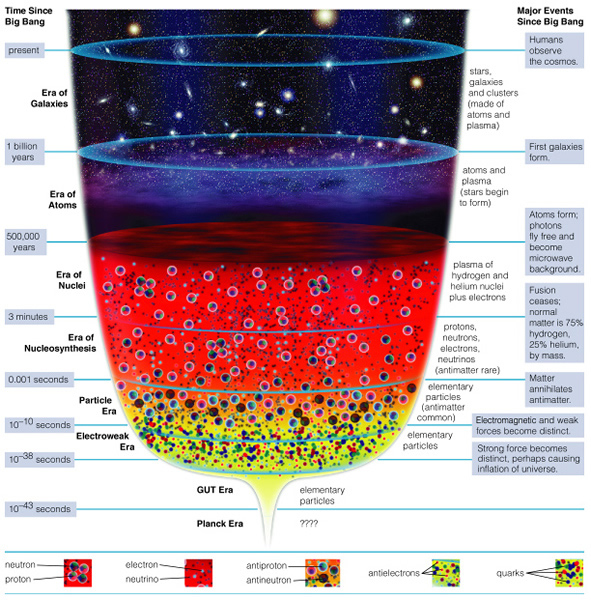
What is Expanding into What? and Other Mind-Boggling Questions
With the inflationary theory, we encounter the notion of space expanding. One of the problems most people have is "if the Universe is expanding, what is it expanding into?". One pictures a balloon being inflated inside the classroom. This is incorrect. First, if the definition of the Universe is "everything", then if the Universe were expanding into something, it would be expanding (a short video on this) into other parts of the Universe! What is happening is that the entire Universe is expanding everywhere. Space expands as time increases. It is not expanding into something, it is merely expanding. Hard to envision, here is a two dimensional example:
The proper way to view the expansion is as a "stretching". As time advances, the space between two galaxies is stretched. That is the space between them grows. It is this stretching which is the real cause of the redshifts in the spectra of distant galaxies. A photon of light emitted by a distant galaxy has its wavelength stretched as it crosses the vast distances of space:
Thus, it is space itself which is expanding, separating the galaxies, which makes them appear to be flying apart. While the redshift we observe for distant galaxies looks just like a Doppler shift due to motion, it is in fact due to an entirely different process! Here's a recent PBS show that attempts to describe "space" (click on "watch the program"). It is hard to think of empty space having properties, but it does. There is actually a well known phenomenon called the "Casmir effect" that demonstrates that "empty" space is full of energy.
If space is expanding, are galaxies, planets, humans, and atoms expanding? Well, no. While the space between everything is in fact expanding (even between electrons and protons in an atom), the other forces in nature (gravity, nuclear, etc.) are (currently, see below!) much stronger and overwhelm the expansion. Only on large scales can this expansion be seen.
Is there a spot/center where the Big Bang occurred? No, everywhere started expanding at the same time. The matter didn't fly out of a point into a surrounding vacuum. Matter and space were created at the same time and the expansion happened everywhere at once.
Is there an edge? No. As we have shown the observable Universe is finite, and has a definable size. But it does not have an edge--an edge implies there is something beyond the Universe, and that violates our definition of Universe. Mathematically, we talk about "space being curved". Everywhere in the Universe, you see the same thing: galaxies moving away from you due to the expansion. This curvature can mean that if you tried to travel in one direction at high speed for a very long time, you would end up where you started at. The best analogy is as if you lived on the surface of a sphere from which you could not escape (that is, you cannot go up or down--just around). If you start in any direction on this sphere and head in a "straight" line, you will eventually return to the spot where you started. Other models for the curvature allow the Universe to be infinite in extent. But since the Universe expands at the speed of light, you could never get to the "edge" of the Universe anyway, since you cannot travel faster than the speed of light!
What came before the Big Bang? Since time (here is another PBS program on the remarkably confusing nature of time ) was created in the Big Bang, there is no before to refer to. It is a question we probably cannot know the answer to with any certainty. To read some of the conjectures, however, go here, and here is a a short video, and another.
Recent Developments As astronomical observations improved over the last few decades, it has become apparent that there is something unseen in the Universe. Astronomers have found that galaxies and stars in galaxies move in a way that suggests that there is a form of unseen matter -- dark matter -- in galaxies (and clusters of galaxies). This dark matter does not interact with other types matter, except through gravity. Currently, most cosmologists believe that the normal matter that we are made of and can see through telescopes only constitutes a few percent of all matter in the Universe! The rest is dark. Only time will tell if this stuff is real, or just due to incorrect/misinterpreted theory and/or observation. But the nature of the bumps in the CMB images, along with the presence of dark matter now allows us to construct models for the Universe that appear to do a good job at producing what we observe.
Recently, there has also been quite a bit of news about the observation that the expansion rate of the Universe is increasing. If this is true, Einstein's regretable idea of a cosmological constant has come back to haunt us! The observations that have lead to this conclusion are based on supernovae. The most distant supernovae appear to be fainter, and hence further away than expected:
This suggests a speeding up of the expansion rate. The only way cosmologists can get GR to have an increasing expansion rate is to introduce the cosmological constant back into the formulation. What this actually means is unclear--there is something called "vacuum energy" which appears to push space apart. In fact, since energy and mass are equivalent to the same thing (E = mc2), in the "flatness = 1.0" formulation, this vacuum energy must account for >70% of EVERYTHING!
(Go here to read more about these ideas.) As yet, there are no fully accepted explations for this, and given the difficulty of the observations, it should probably not be taken too seriously at the moment (theory at the frontiers of knowledge can change very quickly). Recent results from a special satellite mission ("WMAP") have confirmed that most of these ideas are correct. To read about them, go here. The end result is that if the Universe's expansion rate continually increases, everything, even subatomic particles, will eventually be ripped apart. Here is a brief video on the "Big Rip". Here is an entire show on the possible future(s) for the Universe.
1From http://www.laidback.org/~daveg/academic/expandinguniverse/index2.html (The graphics for the Friedmann models are also from this site.)
2From http://www.laidback.org/~daveg/academic/expandinguniverse/index2.html
3From http://ircamera.as.arizona.edu/NatSci102/images/extsteadystate.htm
4This illustration is from the CDROM that comes with the text book "The Cosmic Perspective" by Bennett, Donahue, Schneider and Voit